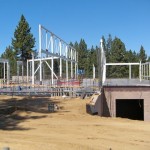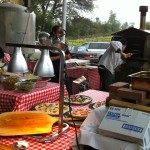By Linda Fine Conaboy
When times are tough in a community, there seem to be multiple indicators signifying just how bad things really are. You see closed storefronts, not much exterior maintenance being done to spruce up buildings, unfinished building projects or simply not many new building starts, and fairly high unemployment.
In the Lake Tahoe region, another indicator is the number of unused building permits (allocations) that have been carried forward, unused from year-to-year.
Normally, by this time, the 2011 permits would have been distributed by the Tahoe Regional Planning Agency. But this year, the designated date is sometime in April. Some in the basin question why and even worry the TRPA will not be issuing allocations this year.

While construction has been robust at South Tahoe High for a couple years, small projects in the basin are near non-existent. Photo/LTN file
Not so, said Jeff Cowen, TRPA community liaison.
Although the agency has also found itself mired in various financial issues mandating reorganization with a plan to eliminate eight positions and reclassify 12 others, the reason for late allocations isn’t an internal staffing issue, he said.
In addition, according to Cowen, the jurisdictions making up the Lake Tahoe Basin are not pounding down the door for allocations. There’s a direct relationship between a lack of requests for allocations and the region’s economic activities, he said.
Although the process of granting building permits or allocations is an intricate one, with many nuances sometimes making it difficult for the lay person to understand, the official definition of an allocation, provided by Cowen is: an apportionment of additional development opportunity for residential, commercial, tourist accommodation and certain recreational projects.
Although this may sound convoluted, it all boils down to who can build where.
“We were not in a hurry to release the allocations this year even though we are closing out the allocations pool from the 1987 Regional Plan. We are a couple of months behind,” Cowen admitted, explaining usually the process is completed in January. However, he said, no new allocations will be allotted until the Regional Plan is updated — an ongoing work in process for a number of years, but according to Cowen, it’s in the final stages of development.
The current Regional Plan, in place since 1987, was set to sunset in 2007.
“Things are contentious in the basin,” he said. “That’s why we’re still working on the plan. We’ve actually been working on it since 2004.”
A bit of history
He said because of runaway growth, TRPA put the brakes on rampant building in 1969.
“Come the 1980s, all the harmful growth was stopped, but [we] failed to put in place practices that would make things good — all the broken stuff was still there. The majority of Tahoe’s development was created without environmental guidelines. The lake’s clarity was still declining.”
In 1997, then-President Bill Clinton and Vice President Al Gore came to Lake Tahoe to establish the Environmental Improvement Program, which is a federal, local, state and private partnership.
And in 2007 the EIP was updated, followed just recently by the potential reauthorization of the Lake Tahoe Restoration Act, which hit the floor of Congress on March 2. This act continues the federal commitment at Lake Tahoe by authorizing $415 million over eight years to improve water clarity, reduce the threat of fire and restore the environment. Cowen said the act has broad support and has a good chance of being approved.
By way of explanation, the area benefitting from the allocation process is located between the Carson Range on the east and the Sierra Nevada on the west, straddling the California-Nevada state line. It consists of a large geographical area including South Lake Tahoe, as well as portions of Douglas, El Dorado, Placer, Carson and Washoe counties. About two-thirds of the region is in California, with the remaining one-third in Nevada.
There are about 50,000 year-round residents within the region, a number that is in decline. With 44,000 developed parcels, about 50 to 65 percent of homes are occupied by seasonal residents. About 13 percent of the region is developed.
Who gets what
While all of the machinations at TRPA may not be apparent to the builder or homeowner who’s anxious to begin a building project, they are important to the overall process.
Although Cowen says he understands the urgency of getting shovels in the ground and the short digging season in the Tahoe basin (May 1-Oct. 15), the simple fact of the matter is that none of the jurisdictions is hammering on the TRPA’s door for allocations. Building is definitely slow, he reiterated.
He said TRPA understands it has a reputation of being dense and obtuse stemming from year’s back. Be he also said the agency has changed a lot.
“We’re on a strict path to improve our business processes,” Cowen said.
At the time this article was written, Cowen said there will be allocations available, but he didn’t know how many. “We’re working on that now.”
In 2009 TRPA issued allocations to local jurisdictions without the normal expiration date at the end of the year.
“So, the 2009 allocations that were distributed have lasted through two building seasons and all but one jurisdiction (Douglas County) still has allocations remaining from that pool as we head into a third year. In the past, that kind of retention would have been unheard of.”
Here’s a distribution recap for 2009-10:
• South Lake Tahoe: 32 distributed with six remaining — these are all on hold for multi-family projects; no single-family available right now
• Douglas County: 15 distributed; none remaining
• El Dorado County: 69 distributed; more than 30 remaining
• Placer County: 50 distributed; 42 remaining
• Washoe County: 40 distributed; 32 remaining.
As far as the total number of allocations remaining for years to come, Cowen said TRPA planners are still working on that figure and will know more in April.
What others think
Jill Bricker, a local Realtor and the governmental relations chair for the South Tahoe Association of Realtors, knows the local market well and has some words of advice.
“If you’re planning to apply for a building allocation now, be prepared to have patience. The staffs at [TRPA], the city and the county have been drastically cut because of consolidation, etc.”
Anyone who can build right now should do so, she said — it creates jobs.
Bricker said STAR and the Sierra Board of Realtors recently completed a joint study, the results of which will be passed on to TRPA and the California Tahoe Conservancy so these agencies can better understand what realtors deal with and how it affects the timing of various projects.
“Although response was limited, the majority of the membership feels allocations are not such a hot commodity anymore,” Bricker said.
“TRPA is one of the toughest planning agencies in the nation and sets the standard for environmental issues and protections when it comes to development. What we are concerned with are commercial allocations and tourist accommodation units, which are now being redefined.”
The TRPA website defines TAUs as a saleable commodity within the Tahoe basin. They are available for purchase from the California Tahoe Conservancy, private parties or can be transferred from existing projects.
Roger Trout is the El Dorado County director of development services and in his position deals with building allocations.
“Quite a few people let their allocations expire and they go back into the pool,” he said. “In the past, we’d get 70, 80, 100 allocations each year and they would all be consumed and we had a waiting list. Now, probably because of the state of the global housing market, the need for allocations has declined.”
Trout said he is hopeful TRPA will issue new allocations and re-supply El Dorado County.
“Back in the 1980s and early 1990s we always had more requests than we had allocations,” Trout said.
Mimi Moss, community development director for Douglas County, concurred with Trout when it comes to the number of requests for allocations, although Douglas County has used all of its for the current time period.
“Previously, Douglas County issued 12-13 allocations per year and we had a waiting list. If someone is not issued an allocation, the list rolls to the next year, which is why we have a large waiting list,” Moss said.
If it’s any consolation to the citizens of Tahoe, the area is not alone in its current building malaise — the entire United States housing market is in the deep doldrums.
According to an article on cnnmoney.com, the housing market can’t catch a break. The article reports that the number of permits issued in February for future housing construction fell to a new all-time low, according to a government report issued recently.
Building permits are down 8.2 percent, nationally, from January, the U.S. Department of Commerce Department said. That was the lowest level seen since the government started tracking the figures in 1959.
But spring is here, soon the snow will melt, the allocations will be issued and life may make a stab at normal. Maybe when the building season opens May 1 the sounds of construction will reverberate throughout the basin.












